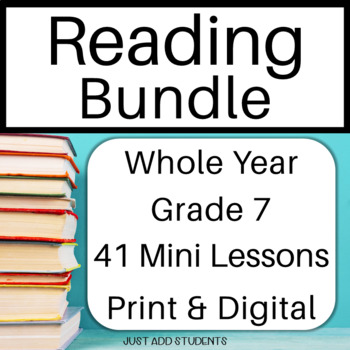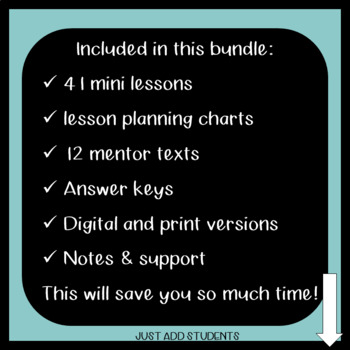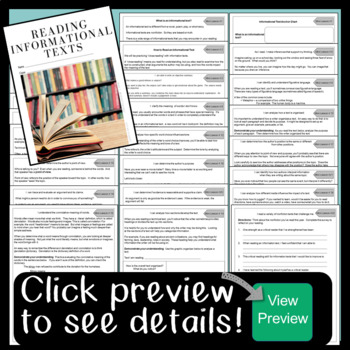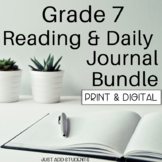Grade 7 Whole Year Reading Informational Text Literature Activities
- Zip
- Google Apps™

What educators are saying
Products in this Bundle (2)
Also included in
- This bundle includes everything you need to teach Grade 7 reading. Mini lessons for reading information texts and literature. Mentor texts included. Plus daily journal prompts that will keep your students writing every day!This is what you'll get:The information text resource includes:22 Mini LessPrice $40.00Original Price $55.98Save $15.98
Description
You'll be able to teach all the 7th grade reading standards with this print and digital bundle. Use with any texts to differentiate and scaffold. You'll love using these mini lessons to break down tasks into manageable lessons that will help students succeed and grow as readers!
Take a look at what's in this bundle:
This resource includes:
- 22 Mini Lessons -- both print & digital
- Two cover choices (one full-color, one blackline) that you can use to create a workbook for your students
- 22 standards posters written in student-friendly language
- four nonfiction texts that you can use right away to start teaching these skills! Included two texts that argue address opposite points.
- Mentor texts are four different reading levels for differentiation
- Each mentor text includes comprehension questions
- lesson planning charts
- Answer Key using the nonfiction texts in the zip file. This will give you an idea of how to use the mini lessons with other texts. You may wish to choose your own nonfiction texts.
- teaching tips to help you get the most out of this jam-packed resource!
Each mini lesson includes:
- a manageable portion of the RI standards
- student friendly restatement of the standard
- easy-to-follow explanation of the standard
- a “Demonstrate your Understanding” that directs the student’s task for the day
- print version: students can cut off the bottom portion of the page to use as an exit card or assessment
- digital version: students can turn in the activity they completed
- students can add notes for each lesson to a digital or print notebook to create a reading resource
- a “Reflection Question” focuses on higher order thinking skills and helps summarize the mini lesson. Ideal "wrap up" or use as a warm up for the next class.
The 22 mini lessons address:
- What is an informational text? Anchor chart
- How to read an informational text (note taking and annotation)
- Cite text evidence & determine two or more central ideas in a text
- Analyze their development over the course of a text
- Provide an objective summary
- Cite several pieces of text evidence to support analysis of inferences
- Analyze the interactions between individuals, events, and ideas
- Determine meaning of words and phrases
- Determine meaning of figurative language
- Determine the meaning of connotative language
- Determine technical meanings
- Analyze the impact of a specific word choice on meaning and tone
- Analyze the structure an author uses
- Analyze how major sections contribute to the whole and development of ideas
- Determine point of view
- Determine author purpose
- Analyze how the author distinguishes position from others
- Compare and contrast a text to audio, video, or multi media
- Trace and evaluate the argument and specific claims
- Assess whether the reasoning is sound and evidence is relevant
- Analyze how two or more authors write about the same topic
- Read and comprehend literary nonfiction
- 19 Mini Lessons
- Digital & print - perfect for blended, distance, or in-person learning!
- 19 standards posters written in student-friendly language
- lesson planning charts
- 8 mentor texts you can use to model or assign to get students working right away
- Additional texts are embedded into several lessons.
- Answer Key using the mentor texts. This will give you an idea of how to use the mini lessons with other texts. You may wish to choose your own literary texts.
Each mini lesson includes:
- a manageable portion of the RL standards
- student friendly restatement of the standard
- easy-to-follow explanation of the standard
- A “Demonstrate your Understanding” that directs the student’s task for the day
- Built in assessments with the print page or digital slide
- A “Reflection Question” focuses on higher order thinking skills and helps summarize the mini lesson. Ideal "wrap up" or use as a warm up for the next class.
The 19 mini lessons address:
- What is Literature? Anchor chart
- Provide an objective Summary
- Cite several pieces of textual evidence to provide explicit evidence
- Cite several pieces of textual evidence to prove inferences
- Determine the central idea & theme of the text (+extra practice)
- Analyze the central idea & theme over the course of the text
- Analyze how particular elements of the story interact & shape the plot
- Determine meaning of words & phrases
- Determine meaning of figurative language
- Determine connotative meaning
- Analyze impact of rhymes
- Analyze impact of repetition (alliteration)
- Analyze how poetic structure contributes to meaning
- Analyze how dramatic structure contributes to meaning
- Analyze how the author develops point of view
- Analyze how the author contrasts point of view
- Compare and contrast a written story to a film or audio version
- Compare and contrast fictional portrayal with historical account
- Self-assess reading growth
You will be able to increase text complexity and student independence by using the mini lesson activities repeatedly throughout the school year with any literary or informational text.
Use this resource again and again!
You are going to love how much time this saves you!!
Please view the preview to see what this product includes.
I’d love to have you follow my store! Click on the green star to get the latest freebies, sales, and products.
I can't wait to hear from you – please let me know how you use this resource & earn TPT credits at the same time! Questions? Pop them in the Q&A below and I'll get right back to you!
With gratitude,
Marypat






